References
- ↑ "Metropolis Management Act 1855", legislation.gov.uk , The National Archives, Vict/18-19 c. 120
- 1 2 Youngs, Frederic (1979). Guide to the Local Administrative Units of England. Vol. I: Southern England. London: Royal Historical Society. ISBN 0-901050-67-9.
- ↑ "Fulham District Board of Works". The Kensington News. 20 March 1886. p. 4.
- ↑ "[Report of the Medical Officer of Health for Fulham]". wellcomelibrary.org. Retrieved 7 September 2024.
